
Whether you live in a rural community that grapples with annual threats of destructive wildfires or in a city that now spends part of every summer inundated with smoke, many across North America have found themselves wondering: what happened to cause such a sudden change in the way our forests burn?
We sat down with Brian Harvey, assistant professor of environmental and forest sciences in the UW College of the Environment, to discuss some of the most frequently asked questions we encounter about the causes of wildfires, how they’re changing and what we can do to limit their impacts on human health and property.
Contents
Are wildfires becoming more common?
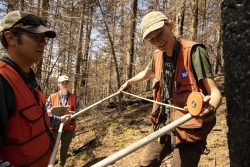
“Absolutely,” said Harvey. “The increase in fire activity over the last several decades has been fairly profound in many regions of the world, and the western U.S. is a pretty stark example of that. From the early 1980s to just before the turn of the century, there was one year where the U.S. exceeded six million acres burned. Since the year 2000, there have now been 13 such years.”
It’s not just you: since the mid-1980s, the average total area burned by wildfires in the western United States has tripled from one million to three million acres, and twenty-seven times more Americans experience at least one day of extreme smoke per year than they did in 2006. Similar trends are occurring all around the world.
What makes these changes even more obvious to the average person, though, is the fact that for much of the 20th century, the western U.S. experienced one of the lowest periods of wildfire activity in recorded history. This was caused by a number of factors: the change in land management practices and attitudes toward fire that accompanied colonization of the western U.S. by Euro-American settlers in the late 1800s; the introduction of livestock that altered the landscape through grazing; large, intense fires in the early 1900s that were followed by public pressure to stop wildfires; and modern fire suppression techniques developed following World War 2 that significantly reduced the overall number and size of wildfires.
So when fire activity started to trend up again after the 1980s and 1990s, it was all the more jarring in contrast.
“Changes to wildfire patterns are documented in the scientific literature,” said Harvey. “They’re front-page news, and now we all have our own shifting baseline of what a normal fire season looks like because we’ve experienced this period of rapid change firsthand. These trends are very real, and we expect them to continue into the future.”
Why are wildfires becoming more common?
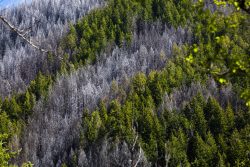
The current increases in wildfire frequency and intensity are driven largely by legacies of land management and contemporary climate change.
“There are three key ingredients that shape wildfire patterns: climate, ignition sources and fuel,” said Harvey. “You need all of the ingredients to line up, and each season you’re rolling the dice. With plenty of fuel available to burn and no shortage of ignitions, a warming, drying climate is loading the dice in favor of fires occurring more often.”
But wildfire dynamics are highly dependent on the location and type of forest ecosystem you’re talking about.
“In many ecosystems, it’s not the amount of area burned, but how fires are burning that is more concerning,” Harvey said. “Even with recent trends, wide swaths of forests across western North America are still burning less than historical levels. But the dominant plants and animals in different ecosystems are adapted to a certain frequency, size and intensity of fires, and when fire characteristics become misaligned with these adaptations, the ecosystems can become less resilient.”
In dry forests, fuel buildup drives more intense wildfires
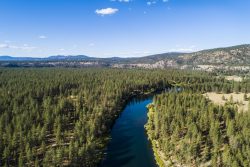
Take, for example, a ponderosa pine forest ecosystem in a dry region of western North America, such as the eastern slopes of the Cascade Mountains or the southwestern U.S. Most summers in these ecosystems are hot and dry, so the weather and climate conditions tend to be favorable for fires.
Ignition sources in these ecosystems — such as lightning strikes and accidental and intentional human causes — are also abundant and have been historically. So with both of those variables creating favorable wildfire conditions, the factor that limited many fires in the past is how much fuel is available to burn.
“In regions like this, the increases in wildfire size, intensity and severity we see in recent decades are commonly due to past fire exclusion and suppression,” said Harvey. “When Indigenous communities were removed from much of their lands, the regular use of fire as a management tool by people became scarce. Then, settlers suppressed the fires that did start, which further allowed trees and vegetation to build up. All of those missed fires, and the corresponding fuel buildup, can make today’s fires bigger and more intense.”
Climate change also plays a role in these areas, as warmer weather dries out vegetation earlier in the year and extends fire season later into the fall. But the cessation of fires over more than a century is a key factor leading to an increase in large and severe fires in historically frequent-fire forests.
In cooler, wetter forests, the role of climate in fires is changing
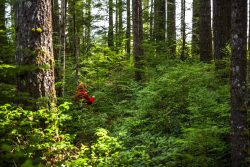
For subalpine forests — those at higher elevations with lots of snow — and in wetter forests such as on the western slopes of the Cascade or Olympic Mountains, the answer is very different. These forests also have ignitions from lightning and human sources, but the cool, damp climate tends to limit fire activity for much of the summer season.
These ecosystems historically did not have as many frequent fires that clear out vegetation like in warmer and drier climates, so the total amount of vegetation today is often more similar to what it would have been hundreds or even thousands of years ago. That means that when fires do start, there is no shortage of fuel to burn.
“As the climate warms, it becomes less of a limiting factor on fires in these ecosystems,” Harvey said. “And as summers grow hotter and drier, fires in many of these areas are expected to become more frequent.”
Can wildfires ever be beneficial?

As we’ve learned, wildfires in many ecosystems were quite a lot more common a few hundred years ago, before Euro-American settlement of western North America and the development of modern fire suppression techniques. So in many situations, the return of fire activity may actually be beneficial.
“When you walk out into the forest, it almost screams at you how important fire has been as an evolutionary force,” said Harvey. “It shapes what these organisms are and how they live, and the removal of fire can really put those species in peril.”
Some plants, like the ponderosa pine, have incredibly thick bark that helps them survive frequent, low-intensity fire. Other species, like aspen and bigleaf maple, are able to re-sprout from their roots or stumps after a fire. Other trees produce specialized cones (known as serotinous cones) that lock their seeds up tight with resin for years until the heat of a fire causes them to open, releasing tens of thousands of seeds all at once from a single tree. In many ecosystems, native plant and animal diversity is greater after a fire than before a fire, as fire creates opportunities that were not present before.
“There are many cases where fires burning today, at least from an ecological standpoint, are beneficial in a lot of ways,” Harvey said. “They can help bring forests to a point where they’re going to be more resilient to a warm and fiery future. In fact, even with the trends of increasing area burned, many forested areas across the western U.S. are still operating at a fire ‘deficit’ compared to the amount of fire that occurred historically. Fire is a critical component of resilience in the forests we know and love.”
Harvey was quick to point out that although wildfires can be beneficial ecologically, fires encroaching on human populations can still be disastrous.
“Quite often there can be fires that are not necessarily large or ecologically catastrophic, but are located in areas where lots of people live and may not be prepared,” he said. “That’s an entirely different equation.”
How can we make wildfires less destructive?

If changing land management practices are part of the cause of the recent uptick in wildfire activity, does that mean management can also help mitigate their destructive impacts on ecosystems and human populations?
“In nearly all forests in western North America, the question is not if fire will come, it’s when,” said Harvey. “So it’s a matter of making sure that we’re adapted to that as best we can be and mitigating any negative impacts. When we have opportunities to let fire do its thing without immediately endangering humans, we can take advantage of them. Then we can focus on fire prevention in areas where it will immediately threaten human lives and property.”
According to Harvey, flexibility and adaptability are the keys to any wildfire management approach. Forest ecosystems are changing rapidly, and each one has unique dynamics that need to be taken into account.
For example, on the dry east side of the Cascade Mountains, clearing out overgrown vegetation and conducting prescribed burns can help reduce the fuel that feeds high-intensity fires. This could help return the ecosystems to the frequent, low-intensity fires that they’re adapted to.
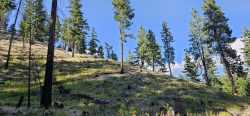
In contrast, on the cooler, wetter west side of the Cascades, fire risk is less likely in any given summer. But when fires do ignite and spread — typically due to hot and dry weather in combination with strong winds — the most important course of action is to get people out of the way as quickly and safely as possible.
“Preparing for the big, wind-driven west-side fires is almost like how we prepare for earthquakes,” Harvey said. “When fires get that big and are moving that fast, it’s not a matter of trying to stop them, it’s a matter of making sure you’re able to get people to safety.”
It’s also important to note that none of these are new ideas. Indigenous communities have been living in these fire-prone landscapes since time immemorial.
“Forest management plans need to be part of broad and inclusive conversations with Indigenous communities,” Harvey said. “People have been living on these lands and with fire for a very long time. Creating room for inclusive perspectives in management practices around fire and forests is essential.”
Is wildfire smoke here to stay?

For those who don’t live directly in the path of wildfires, one of the most disruptive side-effects of their return has been the thick, choking smoke that now covers large swaths of the country during fire season. This smoke has proven to be a major public health hazard, erasing many of the air quality gains of the past several decades and subjecting millions of people to significant acute and chronic health risks.
So if wildfires are here to stay, is there anything we can do about the smoke?
“The question of smoke is tricky,” Harvey said. “We have some choices about how much smoke we create and where it goes when it’s from a prescribed burn, but when it’s a wildfire we don’t. A future without smoke from one source or another is really unlikely in fire-prone landscapes.”
That means that, much like other inevitable natural hazards, the best approach is preparedness.
“It comes down to societal adaptations and making sure that we take measures to protect people as best we can, whether that’s better air filtration in buildings, a public alert system that tells people when and how to limit exposure outdoors, or other measures,” he continued. “There’s been a proliferation of tools and information about air quality and public health in the past several years. In addition to that, we need to equip people to stay healthy and safe.”
Story by Will Shenton

